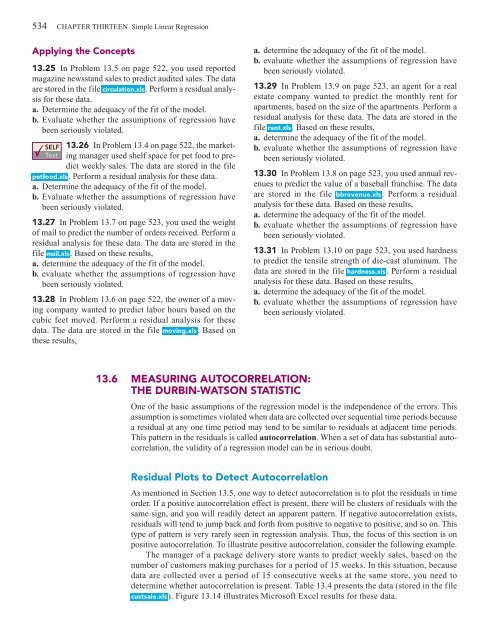CHAPTER 13 Simple Linear Regression
CHAPTER 13 Simple Linear Regression
CHAPTER 13 Simple Linear Regression
Create successful ePaper yourself
Turn your PDF publications into a flip-book with our unique Google optimized e-Paper software.
534 <strong>CHAPTER</strong> THIRTEEN <strong>Simple</strong> <strong>Linear</strong> <strong>Regression</strong><br />
Applying the Concepts<br />
<strong>13</strong>.25 In Problem <strong>13</strong>.5 on page 522, you used reported<br />
magazine newsstand sales to predict audited sales. The data<br />
are stored in the file circulation.xls. Perform a residual analysis<br />
for these data.<br />
a. Determine the adequacy of the fit of the model.<br />
b. Evaluate whether the assumptions of regression have<br />
been seriously violated.<br />
SELF<br />
Test<br />
<strong>13</strong>.26 In Problem <strong>13</strong>.4 on page 522, the marketing<br />
manager used shelf space for pet food to predict<br />
weekly sales. The data are stored in the file<br />
petfood.xls. Perform a residual analysis for these data.<br />
a. Determine the adequacy of the fit of the model.<br />
b. Evaluate whether the assumptions of regression have<br />
been seriously violated.<br />
<strong>13</strong>.27 In Problem <strong>13</strong>.7 on page 523, you used the weight<br />
of mail to predict the number of orders received. Perform a<br />
residual analysis for these data. The data are stored in the<br />
file mail.xls. Based on these results,<br />
a. determine the adequacy of the fit of the model.<br />
b. evaluate whether the assumptions of regression have<br />
been seriously violated.<br />
<strong>13</strong>.28 In Problem <strong>13</strong>.6 on page 522, the owner of a moving<br />
company wanted to predict labor hours based on the<br />
cubic feet moved. Perform a residual analysis for these<br />
data. The data are stored in the file moving.xls. Based on<br />
these results,<br />
a. determine the adequacy of the fit of the model.<br />
b. evaluate whether the assumptions of regression have<br />
been seriously violated.<br />
<strong>13</strong>.29 In Problem <strong>13</strong>.9 on page 523, an agent for a real<br />
estate company wanted to predict the monthly rent for<br />
apartments, based on the size of the apartments. Perform a<br />
residual analysis for these data. The data are stored in the<br />
file rent.xls. Based on these results,<br />
a. determine the adequacy of the fit of the model.<br />
b. evaluate whether the assumptions of regression have<br />
been seriously violated.<br />
<strong>13</strong>.30 In Problem <strong>13</strong>.8 on page 523, you used annual revenues<br />
to predict the value of a baseball franchise. The data<br />
are stored in the file bbrevenue.xls. Perform a residual<br />
analysis for these data. Based on these results,<br />
a. determine the adequacy of the fit of the model.<br />
b. evaluate whether the assumptions of regression have<br />
been seriously violated.<br />
<strong>13</strong>.31 In Problem <strong>13</strong>.10 on page 523, you used hardness<br />
to predict the tensile strength of die-cast aluminum. The<br />
data are stored in the file hardness.xls. Perform a residual<br />
analysis for these data. Based on these results,<br />
a. determine the adequacy of the fit of the model.<br />
b. evaluate whether the assumptions of regression have<br />
been seriously violated.<br />
<strong>13</strong>.6 MEASURING AUTOCORRELATION:<br />
THE DURBIN-WATSON STATISTIC<br />
One of the basic assumptions of the regression model is the independence of the errors. This<br />
assumption is sometimes violated when data are collected over sequential time periods because<br />
a residual at any one time period may tend to be similar to residuals at adjacent time periods.<br />
This pattern in the residuals is called autocorrelation. When a set of data has substantial autocorrelation,<br />
the validity of a regression model can be in serious doubt.<br />
Residual Plots to Detect Autocorrelation<br />
As mentioned in Section <strong>13</strong>.5, one way to detect autocorrelation is to plot the residuals in time<br />
order. If a positive autocorrelation effect is present, there will be clusters of residuals with the<br />
same sign, and you will readily detect an apparent pattern. If negative autocorrelation exists,<br />
residuals will tend to jump back and forth from positive to negative to positive, and so on. This<br />
type of pattern is very rarely seen in regression analysis. Thus, the focus of this section is on<br />
positive autocorrelation. To illustrate positive autocorrelation, consider the following example.<br />
The manager of a package delivery store wants to predict weekly sales, based on the<br />
number of customers making purchases for a period of 15 weeks. In this situation, because<br />
data are collected over a period of 15 consecutive weeks at the same store, you need to<br />
determine whether autocorrelation is present. Table <strong>13</strong>.4 presents the data (stored in the file<br />
custsale.xls). Figure <strong>13</strong>.14 illustrates Microsoft Excel results for these data.

















